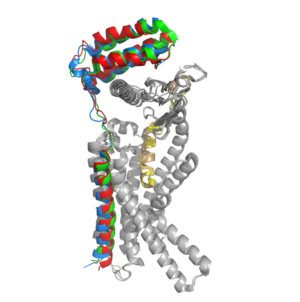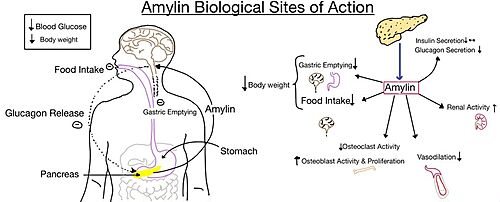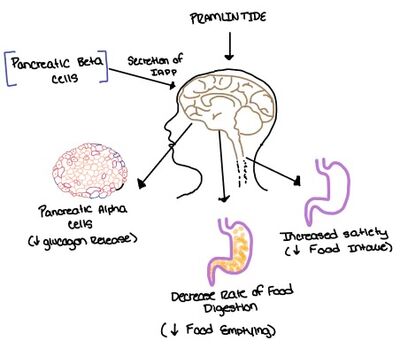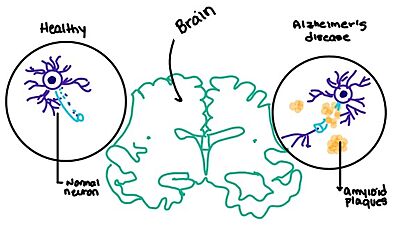User:Jaelin Lunato/Sandbox 1
From Proteopedia
(Difference between revisions)
| Line 1: | Line 1: | ||
=Amylin Receptor (AMYR)= | =Amylin Receptor (AMYR)= | ||
| - | <StructureSection load='7tyf' size='340' side='right' caption='Amylin Receptor (AMYR) with bound amylin ligand in dark yellow. | + | <StructureSection load='7tyf' size='340' side='right' caption='Amylin Receptor (AMYR) with bound amylin ligand in dark yellow. Receptor activity-modifying protein in red, calcitonin receptor core in purple, and G protein in orange. PDB: 7tyf.' scene='10/1037495/Loadingpage/6'> |
== History and Discovery == | == History and Discovery == | ||
| - | In the early 1900s, amyloid protein deposits were found in the pancreatic tissue of diabetic patients. | + | In the early 1900s, amyloid protein deposits were found in the pancreatic tissue of diabetic patients. Later in 1999, the structure of the family of [https://en.wikipedia.org/wiki/Calcitonin_receptor calcitonin receptors] started to be determined, and it was determined that the amylin receptor (AMYR<ref name="7TYF">PMID:35324283</ref>) had a core structure of the calcitonin receptor (CTR). Additionally, it was determined that AMYR had a [https://en.wikipedia.org/wiki/Receptor_activity-modifying_protein receptor activity-modifying protein] (RAMP) bound to the CTR core. In 2000, the CTR and a RAMP was co-expressed in a single cell, and later in 2016 the CTR and a RAMP were both found in rat brain cells. |
[https://en.wikipedia.org/wiki/Cryogenic_electron_microscopy Cryo-electron microscopy] (cryo-EM) was used to determine the structure of the calcitonin receptor and later the structure of AMYR. [https://en.wikipedia.org/wiki/Nuclear_magnetic_resonance NMR] and [https://en.wikipedia.org/wiki/X-ray_crystallography x-ray crystallography] was also used to determine the structure but the resolution was poor relative to cryo-EM. | [https://en.wikipedia.org/wiki/Cryogenic_electron_microscopy Cryo-electron microscopy] (cryo-EM) was used to determine the structure of the calcitonin receptor and later the structure of AMYR. [https://en.wikipedia.org/wiki/Nuclear_magnetic_resonance NMR] and [https://en.wikipedia.org/wiki/X-ray_crystallography x-ray crystallography] was also used to determine the structure but the resolution was poor relative to cryo-EM. | ||
| Line 12: | Line 12: | ||
=== CTR and RAMP Heterodimer === | === CTR and RAMP Heterodimer === | ||
| - | [[Image:Overlay of RAMPs.png|300 px|right|thumb|'''Figure 2.''' Superimposition of RAMP1, RAMP2, and RAMP3. RAMP1 is red, RAMP2 is blue, and RAMP3 is green. | + | [[Image:Overlay of RAMPs.png|300 px|right|thumb|'''Figure 2.''' Superimposition of RAMP1, RAMP2, and RAMP3. RAMP1 is red, RAMP2 is blue, and RAMP3 is green. The amylin ligand is dark yellow, and the calcitonin ligand is pale yellow.]] AMYR is a heterodimer of a calcitonin receptor and a receptor activity-modifying protein. There are three different RAMPs, RAMP1, RAMP2, and RAMP3, that compose AMY1R, AMY2R, and AMY3R when associated with the CTR (Figure 1). The three different RAMPs are structurally similar to each other, so all three RAMPs are able to bind to the CTR without any modification of the CTR (Figure 2) <ref name="Hay">PMID:26071095</ref>. |
| - | In the absence of a RAMP, the calcitonin receptor has greater affinity for calcitonin than amylin, but because the <scene name='10/1037495/Overlay_of_ligands/1'>two ligands are structurally similar</scene>, both calcitonin and amylin can bind to the CTR without any modification of the receptor <ref name="Hay">PMID:26071095</ref>. | + | In the absence of a RAMP, the calcitonin receptor has greater affinity for calcitonin than amylin, but because the <scene name='10/1037495/Overlay_of_ligands/1'>two ligands are structurally similar</scene>, both calcitonin and amylin can bind to the CTR without any modification of the receptor <ref name="Hay">PMID:26071095</ref>. The two ligands have many conserved residues (highlighted in blue), and this shows that the two ligands share many chemical properties which explains why they are structurally similar. In addition to having many conserved residues, both ligands also have an amidated C-terminus (Figure 3). When the CTR is bound to a RAMP, the complex becomes the AMYR and has greater affinity for the <scene name='10/1037495/Ligand_in_membrane/2'>amylin ligand</scene> relative to the calcitonin ligand. Therefore, the RAMP is essential to AMYR because it causes AMYR to have greater affinity for the amylin ligand rather than the calcitonin ligand. [[Image:Sequence alignment ligands.png|450px|left|thumb|'''Figure 3.''' Sequence alignment of rat amylin and salmon calcitonin. Conserved residues are highlighted in blue.]] |
== Ligands == | == Ligands == | ||
| - | The two major ligands of the calcitonin receptor are [https://en.wikipedia.org/wiki/Calcitonin calcitonin] and [https://en.wikipedia.org/wiki/Amylin amylin]. | + | The two major ligands of the calcitonin receptor are [https://en.wikipedia.org/wiki/Calcitonin calcitonin] and [https://en.wikipedia.org/wiki/Amylin amylin]. Calcitonin is a peptide hormone secreted from the thyroid, and it is involved in the regulation of calcium and phosphate in the blood. Amylin is also a hormone and is secreted by pancreatic beta cells. Amylin binding activates many different biological processes affecting different systems with the human body. For example, amylin binding can affect the immune system, the central nervous system, and the satiation system in the brain (i.e., the area postrema)<ref name="Press"> Press, M., Jung, T., Konig, J., Grune, T., & Hohn, A. (2019). Protein aggregates and proteostasis in aging: Amylin and β-cell function. ''Mechanisms of Ageing and Development. 3,'' 46-54. [http://dx.doi.org/10.1016/j.mad.2018.03.010 DOI:10.1016/j.mad.2018.03.010]</ref>. |
There are two required post-translational modifications of amylin in order for the ligand to have any bioactivity: (1) <scene name='10/1037495/C-term_amide/2'>amidation of the C-terminus</scene> and (2) a <scene name='10/1037495/Amylin_disulfide_bond2/4'>disulfide bond</scene> between C2 and C7. The amidated C-terminus of amylin has a nitrogen present which makes three significant hydrogen bonds. There is one hydrogen bond between the end of amylin and the backbone of the CTR and two hydrogen bonds back to the backbone of amylin itself. The amidated C-terminus is essential to the bioactivity of amylin because the Nitrogen participates in Hydrogen bonding and holds the amylin ligand in a specific orientation. Additionally, the hydrogen bonds orient the amylin Y37 residue in a specific orientation so the Y37 side chain can participate in non-polar interactions in the space opposite of the hydrogen bonds. The disulfide bonds between C2 and C7 inhibit the end of amylin from waving around freely, and it prevents amylin from aggregation as well. | There are two required post-translational modifications of amylin in order for the ligand to have any bioactivity: (1) <scene name='10/1037495/C-term_amide/2'>amidation of the C-terminus</scene> and (2) a <scene name='10/1037495/Amylin_disulfide_bond2/4'>disulfide bond</scene> between C2 and C7. The amidated C-terminus of amylin has a nitrogen present which makes three significant hydrogen bonds. There is one hydrogen bond between the end of amylin and the backbone of the CTR and two hydrogen bonds back to the backbone of amylin itself. The amidated C-terminus is essential to the bioactivity of amylin because the Nitrogen participates in Hydrogen bonding and holds the amylin ligand in a specific orientation. Additionally, the hydrogen bonds orient the amylin Y37 residue in a specific orientation so the Y37 side chain can participate in non-polar interactions in the space opposite of the hydrogen bonds. The disulfide bonds between C2 and C7 inhibit the end of amylin from waving around freely, and it prevents amylin from aggregation as well. | ||
== 12 Angstrom Calcitonin Shift == | == 12 Angstrom Calcitonin Shift == | ||
| - | When the RAMP binds to the CTR, the CTR undergoes a conformational change, or shift. | + | When the RAMP binds to the CTR, the CTR undergoes a conformational change, or shift. The extracellular region of the calcitonin subunit, specifically in the C-alpha loop 5, of AMYR will undergo a 12 angstrom shift upwards <ref name="Cao">PMID:35324283</ref>. This distance shift is measured specifically from a glutamate residue, E123. This shift in the CTR facilitates the packing of the CTR extracellular domain with the antiparallel triple helix conformation of the RAMP extracellular domain. |
***** ADD PICTURE HERE OF SHIFT******** | ***** ADD PICTURE HERE OF SHIFT******** | ||
| - | There is little movement in the N-terminal location and midregion of the CTR when RAMP binds. | + | There is little movement in the N-terminal location and midregion of the CTR when RAMP binds. This is because there is an unstructured and flexible "hinge" region between the extracellular domain and the core-binding domains, allowing these domains to remain in their original location from before RAMP binds to the CTR. |
== Binding Site Interactions == | == Binding Site Interactions == | ||
| - | There are <scene name='10/1037496/Amylin_2hbonds/4'>two conserved hydrogen bonds between the CTR and the amylin N-terminus loop</scene>. | + | There are <scene name='10/1037496/Amylin_2hbonds/4'>two conserved hydrogen bonds between the CTR and the amylin N-terminus loop</scene>. These bonds contribute to the functional phenotype of AMYR and also causes the end of the amylin ligand to be held in a flipped up position. |
| - | There are water molecules present in the binding site between amylin and the calcitonin receptor that support the ligand-receptor interaction. | + | There are water molecules present in the binding site between amylin and the calcitonin receptor that support the ligand-receptor interaction. Some water molecules interact with the amylin ligand and create water-bridged Hydrogen bonds between different ligand residues, such as the <scene name='10/1037495/Water_1_ver3/4'>water-bridged Hydrogen bond between the main chains of T6 and T9</scene>. Other water molecules create <scene name='10/1037496/Water_receptor/1'>water-bridged Hydrogen bonds between residues of the calcitonin receptor</scene>. The water molecules are present in the empty space located in the ligand binding site, and they are hypothesized to stabilize the active conformation of the calcitonin receptor when amylin is bound. Substitutions of polar residues involved with the water-bridged Hydrogen bond network to nonpolar residues causes a decrease in potency and affinity of amylin to the calcitonin receptor. (REFERENCE NEEDED HERE******) |
== G Protein Activation == | == G Protein Activation == | ||
| Line 68: | Line 68: | ||
<ref name="Hay"> | <ref name="Hay"> | ||
<ref name="Cao"> | <ref name="Cao"> | ||
| + | <ref name="Press"> | ||
<ref name="Mathiesen"> | <ref name="Mathiesen"> | ||
<ref name="Thapa"> | <ref name="Thapa"> | ||
| - | <ref name="Press"> | ||
<ref name="Grizzanti"> | <ref name="Grizzanti"> | ||
Revision as of 22:18, 24 April 2024
Amylin Receptor (AMYR)
| |||||||||||
References
- ↑ Cao J, Belousoff MJ, Liang YL, Johnson RM, Josephs TM, Fletcher MM, Christopoulos A, Hay DL, Danev R, Wootten D, Sexton PM. A structural basis for amylin receptor phenotype. Science. 2022 Mar 25;375(6587):eabm9609. PMID:35324283 doi:10.1126/science.abm9609
- ↑ 2.0 2.1 2.2 2.3 2.4 Hay DL, Chen S, Lutz TA, Parkes DG, Roth JD. Amylin: Pharmacology, Physiology, and Clinical Potential. Pharmacol Rev. 2015 Jul;67(3):564-600. PMID:26071095 doi:10.1124/pr.115.010629
- ↑ 3.0 3.1 3.2 3.3 Cao J, Belousoff MJ, Liang YL, Johnson RM, Josephs TM, Fletcher MM, Christopoulos A, Hay DL, Danev R, Wootten D, Sexton PM. A structural basis for amylin receptor phenotype. Science. 2022 Mar 25;375(6587):eabm9609. PMID:35324283 doi:10.1126/science.abm9609
- ↑ 4.0 4.1 Press, M., Jung, T., Konig, J., Grune, T., & Hohn, A. (2019). Protein aggregates and proteostasis in aging: Amylin and β-cell function. Mechanisms of Ageing and Development. 3, 46-54. DOI:10.1016/j.mad.2018.03.010
- ↑ Mathiesen DS, Lund A, Vilsbøll T, Knop FK, Bagger JI. Amylin and Calcitonin: Potential Therapeutic Strategies to Reduce Body Weight and Liver Fat. Front Endocrinol (Lausanne). 2021 Jan 8;11:617400. PMID:33488526 doi:10.3389/fendo.2020.617400
- ↑ Thapa, G., Kumari, A., Dasgupta, D., Bandyopadhy, S., Sarkar, N., Roy, K., Karunakaran, G., Kazmi, I., Karmakar, S., & Chakraborty, M. (2023). Chapter 5- Insight into the mechanism of action of anti-diabetic drugs. How Synthetic Drugs Work. 95-122. DOI:10.1016/B978-0-323-99855-0.00005-1
- ↑ Grizzanti J, Corrigan R, Casadesus G. Neuroprotective Effects of Amylin Analogues on Alzheimer's Disease Pathogenesis and Cognition. J Alzheimers Dis. 2018;66(1):11-23. PMID:30282360 doi:10.3233/JAD-180433







